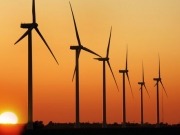
BNEF’s Sydney analysis team comprehensively modelled the cost of generating electricity in Australia from different sources and found that electricity can be supplied from a new wind farm at a cost of $80/MWh (USD $83) compared to $143/MWh from a new coal plant or $116 from a new baseload gas plant. This includes the cost of emissions under the Gillard government’s carbon pricing scheme. Even without a carbon price, wind comes out 14% cheaper than new coal and 18% cheaper than new gas.
“The perception that fossil fuels are cheap and renewables are expensive is now out of date”, said Michael Liebreich, chief executive of Bloomberg New Energy Finance. “The fact that wind power is now cheaper than coal and gas in a country with some of the world’s best fossil fuel resources shows that clean energy is a game changer which promises to turn the economics of power systems on its head.”
According to BNEF’s research, since 2011 the cost of wind generation has fallen by 10% and that of solar PV by 29% while that of fossil-fuelled plants is continuing to rise. Part of the reason for this is the high financing costs involved in the coal sector with Australia’s four largest banks being unlikely to finance new coal without a substantial risk premium, thanks to the reputational damage of emissions-intensive investment. Meanwhile, the expansion of Australian liquefied natural gas (LNG) export markets has forced local prices upwards. Costs for new coal and gas are further exacerbated by the carbon price which is expected to increase substantially over the lifetime of a new plant.
BNEF has also concluded that by 2030 dispatchable renewable generating technologies such as biomass and solar thermal could also be cost-competitive.
This suggests that in future the Australian economy is most likely to be powered extensively by renewables and investment in new fossil-fuel generation will decrease.
“It is very unlikely that new coal-fired power stations will be built in Australia” said Kobad Bhavnagri, head of clean energy research for Bloomberg New Energy Finance in Australia. “They are just too expensive now, compared to renewables. Even baseload gas may struggle to compete with renewables. Australia is unlikely to require new baseload capacity until after 2020, and by this time wind and large-scale PV should be significantly cheaper than burning expensive, export-priced gas. By 2020-30 we will be finding new and innovative ways to deal with the intermittency of wind and solar, so it is quite conceivable that we could leapfrog straight from coal to renewables to reduce emissions as carbon prices rise.”
However, clean energy investment is only likely to increase up to 2020 with support from Australia’s Large-scale Renewable Energy Target due to the fact that existing coal-fired power stations built in the 1970’s have already been paid for and can therefore still produce energy at a lower cost than renewables.
For further information:

